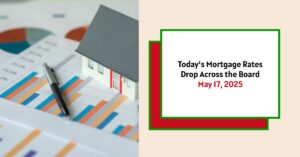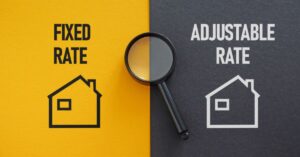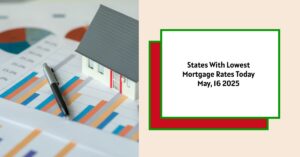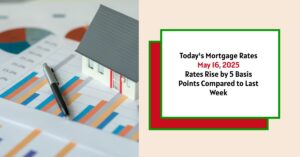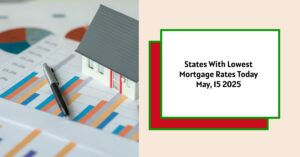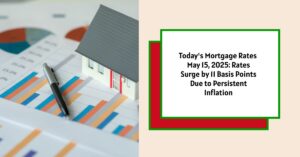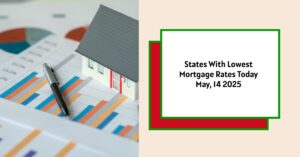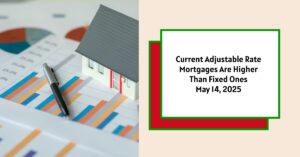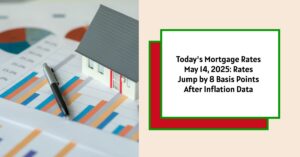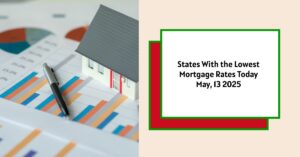As of May 17, 2025, mortgage rates have shown a notable decrease, making it a potentially advantageous time to explore your options. The current average rate for a 30-year fixed mortgage stands at 6.77%, down from previous highs. For 15-year fixed mortgages, rates have dropped to 6.03%. This trend of decreasing rates could encourage homebuyers to take the plunge, especially in light of persistent economic uncertainties.
Today's Mortgage Rates – May 17, 2025: Rates Go Down Notably Across the Board
Key Takeaways
- Mortgage rates have decreased today, creating a favorable environment for buyers and refinancers.
- The 30-year fixed mortgage rate is now 6.77% and the 15-year fixed is at 6.03%.
- It's advisable to lock in your rate in this volatile market to protect against future increases.
- Economic factors such as tariffs and inflation remain influential and could affect future rates.
Understanding Today's Mortgage Rates
Today's mortgage rates represent an important aspect for prospective homebuyers as well as those looking to refinance their existing loans. These rates are influenced by a variety of factors, including economic indicators, inflation, Federal Reserve policies, and even geopolitical events, such as tariffs. It’s crucial to understand how these elements may affect your finances, whether you are purchasing a home for the first time or refinancing an existing mortgage.
Current Mortgage Rates Overview
According to the latest data from Zillow, here are today's average mortgage rates:
| Loan Type | Current Rate |
|---|---|
| 30-Year Fixed | 6.77% |
| 20-Year Fixed | 6.25% |
| 15-Year Fixed | 6.03% |
| 5/1 ARM | 7.08% |
| 7/1 ARM | 7.40% |
| 30-Year VA | 6.31% |
| 15-Year VA | 5.64% |
| 5/1 VA | 6.29% |
Remember, these are average rates and can vary based on location, credit score, and the lender's pricing strategies. For example, individuals in urban areas with high living costs may encounter higher rates compared to those in more rural settings.
Today's Refinance Rates: What You Need to Know
Refinancing can be a great way to lower your monthly mortgage payment and save money over time. As of May 17, here are the average refinance rates:
| Refinance Loan Type | Current Rate |
|---|---|
| 30-Year Fixed | 6.97% |
| 20-Year Fixed | 6.64% |
| 15-Year Fixed | 6.25% |
| 5/1 ARM | 7.56% |
| 7/1 ARM | 7.51% |
| 30-Year VA | 6.47% |
| 15-Year VA | 6.17% |
| 5/1 VA | 6.37% |
While refinance rates are typically higher than rates for new purchases, they can still offer substantial savings, especially if homeowners can bring their rates below their existing loan terms.
Trends Affecting Mortgage Rates as of May 2025
Currently, there are several trends and factors influencing today's mortgage rates.
- Economic Predictions and Tariffs: The economic outlook is mixed. Discussions around tariffs and their impact on inflation lead to uncertainty in the market. Typically, if tariffs raise inflation, mortgage rates may rise as lenders try to mitigate risks. The potential discomfort in the labor market could mean lower rates as a strategy to spur growth.
- Labor Market Dynamics: The labor market has been resilient; however, as slowdowns are expected, a deepening recession could mean lower mortgage rates as demand decreases. Economists monitor various metrics such as employment rates, wage growth, and consumer confidence which all provide clues into how the market might move. An increase in unemployment, for instance, could prompt lenders to offer lower rates to stimulate borrowing and spending.
- Federal Reserve Policies: The actions of the Federal Reserve, including interest rate hikes to combat inflation, directly affect mortgage rates. Higher benchmark rates usually result in increased mortgage rates, while rate cuts tend to lower them. Recently, the Fed's approach has been cautious; they are weighing the risk of inflation against the need to support economic growth. This balancing act can create fluctuations in mortgage rates.
Understanding the Types of Mortgages
The choice between different types of mortgages can significantly affect your financial situation. Below are some insights into various mortgage types:
30-Year Fixed Mortgage
The most common type of mortgage, the 30-year fixed, offers lower monthly payments and predictability.
- Advantages:
- Lower Monthly Payments: Due to the long duration of the loan.
- Predictable Payments: Your interest rate will not change over the life of the loan, making budgeting easier.
- Disadvantages:
- Higher Interest Costs: Over the life of the loan, you will pay more interest.
- Longer Debt: You’re in debt longer than with shorter term loans, potentially delaying other financial goals.
The 30-year fixed mortgage can be ideal for first-time homebuyers, as the lower payments help ease the transition to homeownership. However, over time, many borrowers may consider refinancing or switching to a different mortgage type as their financial situations evolve.
15-Year Fixed Mortgage
The 15-year fixed mortgage is appealing for those wanting to pay off debt faster.
- Advantages:
- Lower Interest Rates: Typically lower than 30-year fixed loans.
- Less Interest Paid Over Time: You will reduce the total interest paid over the life of the loan.
- Disadvantages:
- Higher Monthly Payments: Since you are paying the loan in half the time, your payments are significantly higher.
- Budget Constraints: Higher payments might strain your monthly budget, especially during unpredictable times.
The shorter term means that you can build equity more quickly, which can be advantageous in a rising real estate market. For those who want to retire debt sooner or can handle a higher payment, this option could be a good fit.
Adjustable Rate Mortgages (ARMs)
ARMs, such as the 5/1 ARM, can save money in the short term.
- Advantages:
- Lower Initial Rates: Typically, ARMs have lower initial rates than fixed-rate mortgages.
- Potential Savings: Lower payments if rates remain stable or decrease.
- Disadvantages:
- Rate Uncertainty: After the fixed period, the rates can fluctuate, making budgeting challenging.
- Potentially Higher Payments: If rates increase, your payments could significantly increase, leading to financial strain.
While ARMs can initially provide more affordable options for new homeowners, they can also present risks for those who may not stay in their homes long enough to enjoy the benefits. It’s essential to carefully assess how likely it is that you will stay in that home long term, and if market fluctuations will significantly raise your costs.
Read More:
Mortgage Rates Trends as of May 16, 2025
Dave Ramsey Predicts Mortgage Rates Will Probably Drop Soon in 2025
Future of Mortgage Rates Post-Fed Decision: Will Rates Drop?
Fed's Decision Signals Mortgage Rates Won't Go Down Significantly
Is Now a Good Time to Invest in Real Estate?
Given the current market conditions, many would ask if now is the right time to invest in real estate. It's essential to consider:
- Home Prices and Market Stability: Compared to the height of the pandemic, home prices aren’t surging. This stabilization can signal a good time for buyers. The economic climate has changed significantly, and properties may be more accessible than they were during earlier periods of heightened demand.
- Rate Predictions: While rates have dropped recently, forecasts suggest that they might remain relatively stable or even increase later in the year, making now a suitable time to lock in a rate.
Importantly, timing the market is a risky endeavor. Many experts agree that personal reasons for buying a home, such as life changes or an increase in family size, should provide the primary motivation. A holistic view of your personal circumstances, financial situation, and long-term goals will always be more prudent than waiting for an ideal moment in the market.
Mortgage Rates: What to Expect Moving Forward
Looking ahead, industry forecasts from Fannie Mae and the Mortgage Bankers Association suggest:
| Forecaster | Q2/25 | Q3/25 | Q4/25 | Q1/26 |
|---|---|---|---|---|
| Fannie Mae | 6.5% | 6.3% | 6.2% | 6.1% |
| MBA | 7.0% | 6.8% | 6.7% | 6.6% |
The consensus indicates a gradual decline over the next few quarters, driven by economic factors that may include inflation pressures and labor market concerns. However, these projections can fluctuate due to unforeseen economic developments. Understanding how to read these forecasts can empower prospective buyers and homeowners alike, making it easier to make sound decisions based on reliable information.
The Bottom Line Regarding Mortgage Rates
While fluctuating market conditions and economic indicators pose uncertainties, the current drop in mortgage rates may present favorable conditions for home buyers and those looking to refinance. Understanding the nuances of various mortgage options can aid you in making informed financial decisions moving forward. As you navigate this landscape, keep in mind that knowledge is not just power; it’s peace of mind in an otherwise tumultuous economic environment.
Invest Smarter in a High-Rate Environment
With mortgage rates remaining elevated this year, it's more important than ever to focus on cash-flowing investment properties in strong rental markets.
Norada helps investors like you identify turnkey real estate deals that deliver predictable returns—even when borrowing costs are high.
HOT NEW LISTINGS JUST ADDED!
Connect with a Norada investment counselor today (No Obligation):
(800) 611-3060
Also Read:
- Will Mortgage Rates Go Down in 2025: Morgan Stanley's Forecast
- Expect High Mortgage Rates Until 2026: Fannie Mae's 2-Year Forecast
- Mortgage Rate Predictions 2025 from 4 Leading Housing Experts
- Mortgage Rates Forecast for the Next 3 Years: 2025 to 2027
- 30-Year Mortgage Rate Forecast for the Next 5 Years
- 15-Year Mortgage Rate Forecast for the Next 5 Years
- Why Are Mortgage Rates Going Up in 2025: Will Rates Drop?
- Why Are Mortgage Rates So High and Predictions for 2025
- Will Mortgage Rates Ever Be 3% Again in the Future?
- Mortgage Rates Predictions for Next 2 Years
- Mortgage Rate Predictions for Next 5 Years
- Mortgage Rate Predictions: Why 2% and 3% Rates are Out of Reach
- How Lower Mortgage Rates Can Save You Thousands?
- How to Get a Low Mortgage Interest Rate?
- Will Mortgage Rates Ever Be 4% Again?
